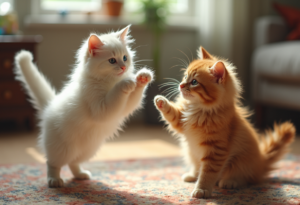Cats are notoriously independent creatures, often grooming themselves with precision and grace, but that doesn’t mean they don’t need a little help from their human companions now and then! As a responsible cat owner, ensuring your feline friend remains happy and clean is paramount to their overall well-being. From battling pesky mats in their fur to maintaining optimal nail length, grooming is more than just a cosmetic concern; it’s a vital part of their health routine. In this blog post, we’ll explore essential grooming tips and tricks that will transform the grooming experience into a delightful bonding time with your cat. We’ll cover everything from the right tools to use and techniques for different coat types, to creating a stress-free environment for your furry companion. Get ready to embark on a journey to purr-fect grooming that will leave your cat feeling fabulous and looking their best!

1. Understanding Your Cat’s Coat Type
Understanding your cat’s coat type is crucial for effective grooming and maintaining your feline friend’s overall health and happiness. Cats come in a variety of coat types, ranging from short and sleek to long and fluffy, and each requires a tailored approach to grooming.
Short-haired breeds, such as the American Shorthair or the Siamese, typically require less maintenance but still benefit from regular brushing to remove loose hairs and reduce shedding. A soft-bristle brush or a grooming glove can work wonders, helping to keep their coat shiny and healthy while also providing a soothing experience for your cat.
On the other hand, long-haired breeds, like the Maine Coon or Persian, necessitate more diligent grooming routines. Their luxurious coats can easily become matted if not properly maintained. Daily brushing is ideal to prevent tangles and keep their fur looking pristine. A wide-toothed comb can help detangle any knots, while a slicker brush will effectively remove dead hair and debris.
For cats with unique coat types—such as curly-haired breeds like the Cornish Rex or the LaPerm—specific grooming tools and techniques are essential. These cats benefit from specialized combs designed to maintain their distinctive texture while preventing matting.
Beyond just the coat length and texture, it’s also important to observe your cat’s skin condition. Signs of irritation, excessive scratching, or bald patches could indicate underlying skin issues that may require veterinary attention. Keeping an eye on your cat’s coat type and condition allows you to adjust your grooming routine as needed, ensuring your furry companion stays happy and clean.
Ultimately, understanding your cat’s coat type not only enhances their appearance but also strengthens the bond between you and your pet, turning grooming into a cherished ritual of care and affection.
Did you know grooming helps prevent hairballs? Learn more in our article on cat hairball prevention.
2. Essential Grooming Tools Every Cat Owner Needs
When it comes to keeping your feline friend happy and clean, having the right grooming tools is essential. A well-groomed cat not only looks great but also feels comfortable and is less prone to health issues. Here’s a rundown of essential grooming tools every cat owner should have in their arsenal.
1. Cat Brush or Comb: A quality cat brush or comb is a must-have for any cat owner. Depending on whether your cat has short or long hair, you might prefer a slicker brush for detangling or a bristle brush for smoothing out their coat. Regular brushing helps remove loose hair, reduces shedding, and prevents matting, making it a fantastic bonding activity between you and your pet.
2. Nail Clippers: Keeping your cat’s nails trimmed is essential for their health and your furniture’s longevity! Look for a pair of cat-specific nail clippers, which are typically designed to make the process easier and safer. Regular nail trimming can help prevent painful splinters or broken nails, contributing to your cat’s overall well-being.
3. Cat Shampoo: For those rare occasions when your cat needs a bath, opt for a gentle cat shampoo specifically formulated for felines. Cats have sensitive skin, and using a product designed for them will help maintain their coat’s natural oils and avoid irritation.
4. Ear Cleaner: Cats are prone to ear wax buildup and infections, especially if they have floppy ears. A vet-recommended ear cleaner can help you maintain your cat’s ear hygiene. Regularly checking and cleaning your cat’s ears can prevent issues and keep their ears healthy.
5. Toothbrush and Cat Toothpaste: Dental health is often overlooked in cats, but it’s crucial for their overall health. Invest in a cat-sized toothbrush and toothpaste designed specifically for cats. Regular brushing can help prevent dental disease, bad breath, and other health problems associated with poor oral hygiene.
6. Grooming Gloves: For cats that are less enthusiastic about traditional grooming tools, grooming gloves can be a game-changer. These gloves allow you to pet your cat while simultaneously removing loose hair and dirt, making grooming a more enjoyable experience for both of you.
7. Flea and Tick Comb: Even indoor cats can fall victim to fleas and ticks. A fine-toothed flea and tick comb is an effective tool for detecting and removing these pests. Regular checks can help you catch infestations early, ensuring your cat stays comfortable and healthy.
Stay ahead of pests with our guide on preventing fleas and ticks.
By equipping yourself with these essential grooming tools, you’ll not only keep your cat looking their best but also foster a deeper bond with your furry companion. Regular grooming sessions can be a wonderful way to show your love and care, making both you and your cat happier in the long run.
3. Step-by-Step Grooming Techniques
Grooming your feline friend is not just about keeping them clean; it’s also a wonderful way to bond with your cat and ensure their overall health and happiness. To help you master the art of cat grooming, here’s a step-by-step guide to make the process smooth and enjoyable for both you and your pet.
Step 1: Gather Your Supplies
Before you begin, make sure you have all the necessary grooming tools at hand. This typically includes a high-quality brush suitable for your cat’s coat type (slicker brushes for long-haired cats and bristle brushes for short-haired breeds), nail clippers, a comb, and possibly a gentle cat shampoo for bath time. Having everything ready will make the grooming session more efficient and less stressful.
Step 2: Create a Calm Environment
Choose a quiet, comfortable space where your cat feels safe. You might want to lay down a soft blanket or towel. Ensure the area is free from distractions and loud noises, which can make your cat anxious. Soft music or gentle talking can help soothe them as you start the grooming process.
Step 3: Brush Your Cat’s Fur
Begin by gently brushing your cat’s fur, starting from their head and moving towards their tail. Take your time, being mindful of sensitive areas like the belly and under the chin. For long-haired cats, be particularly careful to avoid tangles; you may need to use the comb to work out any knots gently. Regular brushing helps reduce shedding and matting, and it’s a great opportunity to check for any skin issues or parasites.
Step 4: Nail Care
After brushing, it’s time to tackle those claws.Gently grasp the cat’s paw and pay attention to the pad, making sure to apply pressure against the pad so that the claw can be further exposed. Trim just the tip of each nail, avoiding the pink area known as the quick, which can bleed and cause pain. If your cat is particularly squirmy, consider using a nail grinder as an alternative to clippers, as it can be less intimidating for them.
Step 5: Bath Time (if necessary)
Most cats groom themselves effectively, but if your furry friend has gotten into something sticky or particularly smelly, a bath may be in order. Fill a basin or your tub with a few inches of lukewarm water, and gently place your cat in it, speaking reassuringly the whole time. Use cat-specific shampoo and rinse thoroughly, ensuring no soap residue remains. Always have a towel ready to wrap them up snugly once they are clean.
Step 6: Finish with a Treat
After the grooming session, reward your cat with a treat or some extra cuddles. This positive motivator ensures that they relate grooming to good experiences which subsequently makes the first sessions much easier and enjoyable.
By incorporating these step-by-step grooming techniques into your routine, you not only help maintain your cat’s cleanliness and well-being but also strengthen the bond you share with them. A well-groomed cat is a happy cat, so get ready to enjoy those purrs of contentment!

4. Tips for Creating a Stress-Free Grooming Environment
Creating a stress-free grooming environment for your cat is crucial to ensure a positive experience for both you and your feline friend. Start by selecting a quiet, comfortable space where your cat feels safe and at ease. This can be a designated grooming area with soft bedding or a favorite blanket, away from loud noises and distractions. Cats are naturally curious and sensitive creatures, so it’s important to have all your grooming tools—such as brushes, clippers, and nail trimmers—within reach, allowing for a smooth and uninterrupted grooming session.
Next, it is highly beneficial to introduce your cat to grooming gradually. Begin by simply allowing your cat to explore the grooming tools without any pressure. This helps them associate the items with positive experiences rather than fear. You can use treats and gentle praise to encourage their curiosity, creating a positive reinforcement loop.
Timing is also key. Choose a time when your cat is calm and relaxed—perhaps after a meal or play session. Avoid grooming when your cat seems agitated or hyperactive. Additionally, consider using calming pheromone sprays or diffusers that can help create a soothing atmosphere.
Lastly, always pay attention to your cat’s body language during grooming. If they show signs of stress or discomfort, such as twitching tails or flattened ears, take a break. A gentle approach that respects your cat’s feelings will foster trust and make grooming a more enjoyable experience for both of you. Remember, the goal is to turn grooming into a bonding activity rather than a chore, ensuring your cat remains happy, clean, and well-groomed!
5. Maintaining Your Cat’s Nail Health
Maintaining your cat’s nail health is an essential aspect of grooming that often gets overlooked. While cats are known for their natural ability to keep their claws sharp and trimmed, it’s still important for pet owners to take an active role in ensuring their feline friends’ nails are well cared for. Overgrown nails can lead to discomfort and even health issues, such as nail splits or infections.
To start, familiarize yourself with your cat’s nail anatomy. Each claw has a delicate pink area called the quick, which contains blood vessels and nerves. When trimming, be sure to avoid cutting into this area, as it can cause pain and bleeding. For our more adventurous cats, a pair of specialized cat nail clippers can make the process much easier. Look for ones that allow for a clean, precise cut to minimize any discomfort.
Setting a routine is vital for nail maintenance. Aim to check your cat’s nails every few weeks. If your cat is reluctant, try to associate nail trimming with positive reinforcement. Offer treats or engage in playtime afterwards to create a more enjoyable experience. For particularly anxious cats, you might want to wrap them gently in a towel, leaving only one paw exposed to help keep them calm.
In addition to regular trimming, providing scratching posts or pads can help keep your cat’s nails naturally filed down. Cats instinctively scratch to shed old layers of their claws, mark their territory, and stretch their muscles. Offering a variety of textures, such as carpet, sisal, or cardboard, can also encourage your cat to engage in healthy scratching behavior.
Finally, don’t forget about regular inspections. While you’re grooming, take the time to check for any signs of injury, infection, or unusual growths around the nails. Early detection can save your cat from unnecessary discomfort and ensure they stay happy and healthy. By incorporating these nail care tips into your grooming routine, you’ll not only keep your cat looking its best but also contribute significantly to its overall well-being.

6. Bonding with Your Cat Through Grooming Activities
Grooming your cat is not just about keeping their fur clean and free of tangles; it’s an incredible opportunity to strengthen the bond between you and your feline friend. Cats are known for their independent nature, but they also crave affection and connection. Engaging in grooming activities can transform a mundane chore into a delightful experience that fosters trust and companionship.
Start by creating a calm environment; choose a comfortable spot where your cat feels safe, such as a cozy corner or a sunny patch on the floor. Gently introduce grooming tools, like a soft brush or a comb, allowing your cat to sniff and investigate them before you begin. This helps to ease any apprehension they may have about the process. Use slow, gentle strokes, and pay attention to your cat’s reactions. If they seem to enjoy it, continue; if they appear stressed or agitated, take a break and try again later.
Incorporate treats and praise into the grooming session to reinforce positive behavior. A little reward goes a long way in making your cat associate grooming with enjoyable experiences. You can even turn grooming into a playful activity by using a brush with built-in toys or by hiding treats in their grooming area, making it feel like a fun adventure rather than a chore.
Also, don’t underestimate the power of quiet time spent together. While you groom, talk softly to your cat or play soothing music in the background. This will create a relaxed atmosphere, encouraging your cat to enjoy the moment. Over time, your grooming sessions will not only keep your cat looking their best but will also deepen your bond, making it a cherished part of your daily routine. Whether you’re tackling tangles or simply enjoying some quality time together, grooming can be a purr-fect avenue for nurturing your relationship with your beloved pet.
As we wrap up our guide on grooming your beloved feline friend, we hope you’re feeling inspired and equipped with the tips and tricks to ensure your cat stays happy and clean. Regular grooming not only enhances your cat’s appearance but also strengthens the bond between you and your furry companion, promoting a sense of security and well-being. Remember, patience is key, and each grooming session can turn into a delightful ritual of connection. Whether it’s brushing, bathing, or simply spending quality time together, your efforts will be rewarded with a content and healthy cat. For more insightful tips and resources, be sure to explore our blog on Blogger, where you can find a wealth of information to enhance your pet care journey. Thank you for joining us, and may your grooming adventures be filled with purrs and joy!


